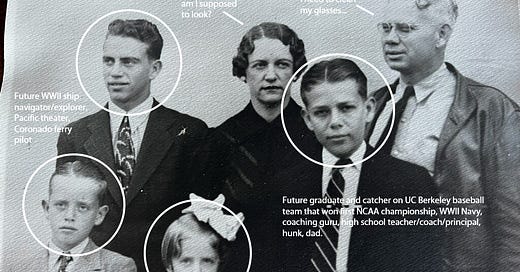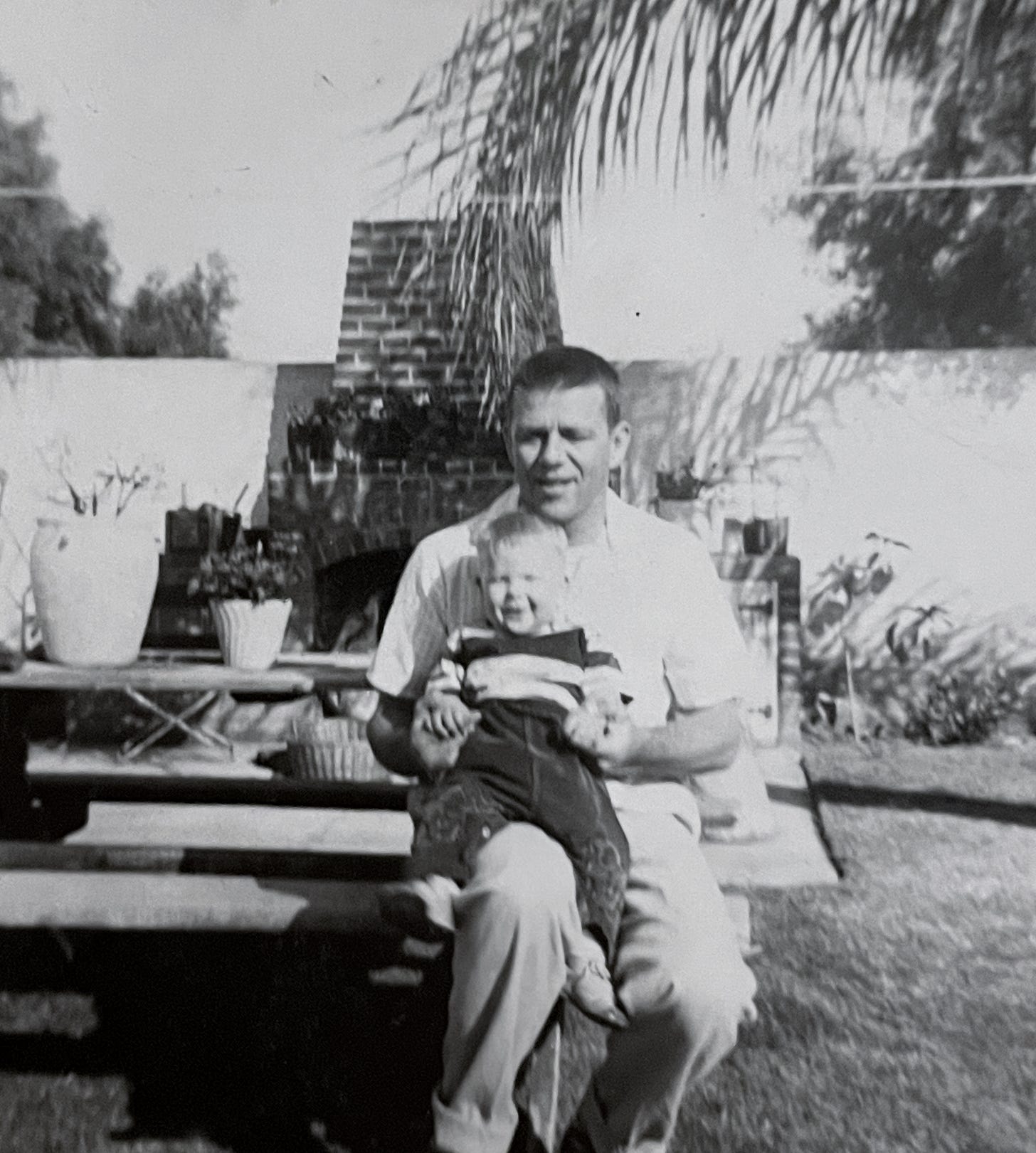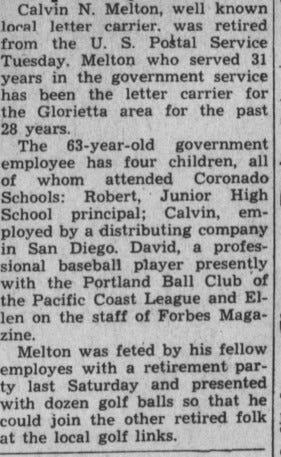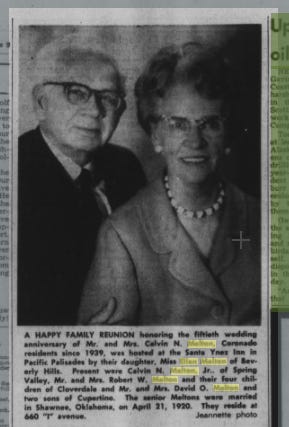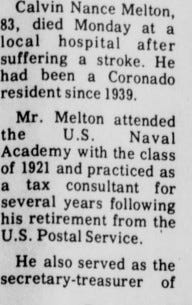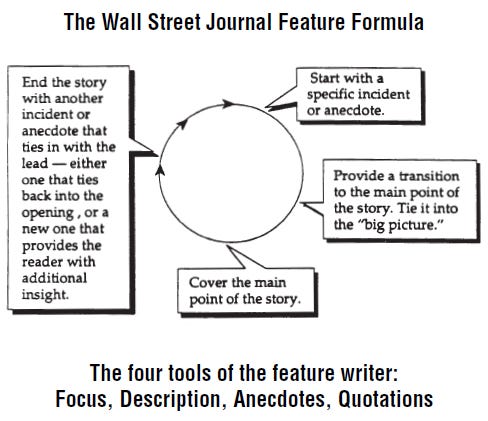Fortune teller photo fun for family
The premise is this: They don't know where they are headed--but we do. Sometimes we find a family photo that serves up the future deliciously, or just for fun, by adding a few prescient cutlines.

Your assignment, just for fun: Find a family photo, and write captions to go over each of the characters in your family story. Share it with family, friends—or here. It’s fascinating how effectively this becomes a fill-in-the-blanks writing prompt.
First of all, for your reference, my dad is the catcher on the UC Berkeley baseball team, the only one besides his sister who is staring directly at the camera.
Second, this piece is about how to start writing a story. [After I finished this I realized this is the story about my grandfather I’d been trying to write for decades, so consider it a first draft—because it is! This process works! Trust me.]
Third, I’ve already shared the biography of my dad you may have seen. (My siblings are free to write their own, of course.) I have finally written one about uncle Dave since one of his sons sent me a couple of boxes of his dad’s baseball memorabilia and family photos. Story for another day, tell me if you are interested.
Fourth, I try to picture who I am telling a story to, and it usually isn’t the others in the family who are Serious Writers. No, I picture a cousin who is grateful for the anecdotes and stories, and loves what I write, and always starts any fixes needed with something like, “Wouldn’t it be fun if you….”Usually, I already know about the fixes and just want to give them something to fix. It’s a human writing need.
Fifth, I dare you to share a first draft of your work like I am doing here!
Okay, to begin again. Look at the top picture of my grandfather.
His mother was first married to a preacher (and the preacher had several wives and is buried in Utah), and when she left him with the kids, she hooked up with a farmer in Kansas (a story I confirmed through DNA) which wasn’t yet a state (and had no laws about marriage, records, and a lot to do with free love) and gave birth to him in Oklahoma.
My grandfather apparently spent most of his life being ashamed of who he was. When he was two, his mother Minnie Melton dropped him off with her parents to get married again, and the Oklahoma census listed his name (living with his grandparents) as “Calvin Guy Wilkins.”
By the 1910 census, as well as school records, it had been changed to “Calvin G. Melton” when he was living with his grandparents. When he was 18, he changed his name to “Calvin Nance Melton”, he wrote, to honor the grandfather and grandmother who had raised him as their son in a letter shared with our family.
And speaking of AncestryDNA, that’s how I uncovered the rest of his story. I had some seriously solid DNA matches, and when I contacted one of them, she revealed that my grandfather lived only 50 miles away from his DNA father, over the Oklahoma/Kansas border.
She wrote: “I only knew Stillman by the name ‘Guy’ until after my grandmother's death and I started searching for information about him because I never heard anything other than they were in Kansas.”
That was the moment I knew. My great-grandmother had left a clue after all, his middle name, “Guy.” My early research revealed it, the census showed it, and the DNA proved it.
The farmer’s first-born was Arthur, followed by seven girls, so he could have used another boy on the farm, and maybe his mother didn’t want that life for him. We’ll never know, but two years later she and Edward or Earnest Welborn married and had five lovely children who were close with my grandfather. (Usually the earlier record is correct, which is why I include “Edward.”)
This contradicts the family backstory of the “illegitimate” son who was raised by his grandparents and abandoned by his mother and father. Oh boy.
And the family passed down his father’s last name as Wilkerson, but it turns out that name was the county in Louisiana my grandmother was born in. According to the census, they could all read and write, but it appears that there was a massive cover-up of the real story. (Rob Melton, journalist, on the story.)
By the time he was a young man in his 20’s, he was editor/publisher of a weekly newspaper in the Texas panhandle when the Dust Bowl hit, displacing millions of farmers who headed west. He landed in San Diego near his mother’s third family. He briefly attended West Point military school and left voluntarily.
Next he became a driver delivering donuts to restaurants, often with his sons. Dave grabbed a donut one day and my dad tried to get it from him, and Dave threw it into the ocean rather than let my dad have it. That was the beginning of their baseball careers and rivalry.
When I look at the picture at the top, my dad looks about 14 (hey, I can tell because I taught high school freshman English, Journalism, and Photography for 41 years). The family had already fled west because of the Dust Bowl in the Middle of the Great Depression and were now in San Diego (all corroborated with census and annual business journals with everyone’s name and address in them—an early phone book).
Looking through those early phone books, which were more ads than numbers, I noticed something peculiar—they moved every year over a 10-year period to a new place in the neighborhood, before jumping over to Coronado. Whether they “can’t pay the rent” or were “movin’ on up”, we’ll never know.
(BTW, my father-in-law and I have performed this routine for the kids and the grandkids for decades, and if I’m being honest, for my students as the opening act to my unit on Drama. I also enjoyed the horrified looks of some students who thought I’d lost my mind. I definitely love the new ending! All you need is a dinner napkin or cloth.)
Eventually, my grandfather moved to Coronado Island and became a postman, where he and the family were featured almost weekly in the small newspaper, undoubtedly because as a postman and former journalist he would stop and talk with people on his route to feed the paper the tidbits they relied on for their news pages.
I knew my grandfather and aunt were journalists, but not when I made my first neighborhood newspaper on a ditto when I was in third grade, then on to high school and local weekly editor. Journalism school led to daily newspaper work, and to teaching journalism, back when we believed in providing community news so citizens could make decisions in elections. You also have to enjoy talking with people, and writing, and doing it fast and accurately. Teaching is also like that. You actually discover new things flowing out of your fingers when you write your first draft, too.
I think my grandfather eventually found success of a sort. On one trip to Southern California to see our grandparents and bodysurf on the beach with our dad, he offered my brother and I Rolexes, which our mother refused.
Just as he served in WWII, so did his three sons, and you can see the arch of their lives in the phrase under the circle in the photo at the top. And that’s how you start a new story about your family.
P.S.: If you have a photograph or painting and a stream-of-consciousness story that arises from it, then you’ve got material for your next family party or event! Or if you are into writing biographies, this is a first draft to which you can add all the factual information from FamilySearch (free), directories, newspapers, oral or written stories, censuses, or more. The future in genealogy is story telling! If you want to make it up (fiction) then change a few names and fill in the blanks and you’ll probably have a bestseller on your hands—at least with your family audience.
-30-
facts of life: A few stories about dad
My siblings and I used chat to gather first-person stories and reminiscences about our father. Then I polished them a bit, and finding the collage a bit unstructured, rewrote it a couple of more times. In the process, I learned more about him through newly discovered scrapbooks, as well as more about myself. Enjoy!
Well, it seems like we are all discovering stories from our past this weekend. Here’s Jack Ohman’s piece about discovering his family history:
Seven strategies to break through brick walls, grow your family tree, and tell their stories
People tend to group all the passengers on the Mayflower as one group, when in fact there were four groups: The Separatists seeking religious freedom, families and individuals recruited by London merchants, indentured servants, and Mayflower sailors who contracted to stay a year in New Plymouth. I like the way familysearch.org breaks it down and offers …
Rob Melton is a reader-supported publication. To receive new posts and support my work, consider becoming a free or paid subscriber.


